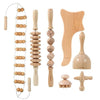
A Comprehensive Guide to Lumbar Disc Herniation and its Connection to Back Pain
Introduction
Back pain is a common complaint that affects people of all ages, with various potential causes. One such cause is lumbar disc herniation, which can result in significant discomfort and limitations in daily activities. In this article, we will explore the relationship between lumbar disc herniation and back pain, and discuss some potential solutions, including the use of EMS and TENS devices, which may provide relief without invasive treatments or strong medications.
What is Lumbar Disc Herniation?
Lumbar disc herniation, also known as a slipped or ruptured disc, occurs when the soft, gel-like center of an intervertebral disc in the lower back (lumbar spine) pushes through a tear in its tough outer layer. This can irritate nearby nerves and result in pain, numbness, or weakness in the lower back, buttocks, and legs.
Causes and Risk Factors
There are several factors that can contribute to the development of lumbar disc herniation, including:
- Age: As we grow older, our intervertebral discs lose water content and become less flexible, increasing the risk of herniation.
- Genetics: Some individuals may have a genetic predisposition to disc herniation.
- Occupation: Jobs that require heavy lifting, bending, or twisting can increase the risk of disc herniation.
- Poor posture: Slouching or maintaining poor posture can place additional strain on the lumbar spine, increasing the risk of herniation.
- Obesity: Excess body weight places additional stress on the lumbar spine, increasing the risk of disc herniation.
How Lumbar Disc Herniation Causes Back Pain
When a lumbar disc herniates, it can compress or irritate nearby nerve roots, causing inflammation and pain. This pain may be localized to the lower back or radiate down the buttocks and legs, a sensation commonly known as sciatica. The severity of the pain can vary from person to person, and may be exacerbated by certain movements or positions.
In many cases, lumbar disc herniation can be treated conservatively, without the need for surgery.
- Rest: It's important to give your back time to heal, avoiding heavy lifting and strenuous activities for a short period.
- Physical therapy: A physical therapist can teach you exercises to strengthen your back and core muscles, improving flexibility and reducing pain.
- Medications: Over-the-counter pain relievers and anti-inflammatory medications can help manage pain and inflammation associated with lumbar disc herniation.
The Role of EMS and TENS Devices in Managing Back Pain
Electrical Muscle Stimulation (EMS) and Transcutaneous Electrical Nerve Stimulation (TENS) devices have gained popularity as non-invasive, drug-free alternatives for managing back pain. These devices work by delivering mild electrical currents to the affected area, which can help reduce pain and promote healing in different ways.
EMS devices are designed to stimulate muscle contractions, which can help improve muscle strength and endurance. This may be particularly beneficial for individuals who are unable to engage in traditional exercise due to pain or mobility limitations. Strengthening the muscles that support the spine can alleviate some of the pressure on the affected disc, potentially reducing pain and discomfort associated with lumbar disc herniation.
TENS devices, on the other hand, are primarily used for pain management. They work by sending electrical pulses through the skin, which can interrupt pain signals sent to the brain and help the body release endorphins, its natural pain-relievers. TENS therapy can provide temporary relief from back pain, allowing individuals to participate in physical therapy and other rehabilitative exercises with greater comfort.
It's important to note that while EMS and TENS devices can be useful tools in managing back pain, they should not be considered a standalone treatment for lumbar disc herniation. They are most effective when used in conjunction with a comprehensive treatment plan that includes physical therapy, medication management, and lifestyle modifications.










Leave a comment